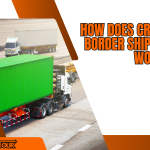Cross-border shipping is a critical component of international trade, allowing goods to travel between countries efficiently. However, the process can seem complex due to varying regulations, documentation, and logistics involved. Whether you’re a business expanding into new markets or an individual shipping goods internationally, understanding how cross-border shipping works can help you make informed decisions and streamline your shipments.
At Detour Freight Inc., we specialize in making cross-border shipping seamless, cost-effective, and reliable. In this blog, we’ll walk you through the process of cross-border shipping and highlight the key considerations to ensure your goods arrive safely and on time.
1. Understanding Cross-Border Shipping: The Basics
Cross-border shipping refers to the movement of goods between two or more countries. This process involves multiple stages, including transportation, customs clearance, and final delivery. Depending on your shipment’s origin and destination, the logistics may involve land, sea, or air freight.
The key challenge of cross-border shipping is navigating the different laws, regulations, and requirements each country has in place. Whether you’re shipping from the U.S. to Canada or between countries in the European Union, you need to ensure compliance with the local rules governing imports, exports, and customs procedures.
2. The Role of Customs in Cross-Border Shipping
Customs is one of the most critical aspects of cross-border shipping. When goods move across international borders, they must be cleared by customs authorities before entering the destination country. This process ensures that shipments comply with the importing country’s regulations, tariffs, and taxes.
What’s Involved in Customs Clearance?
- Customs Declaration: A detailed document listing the contents of the shipment, its value, and its origin. This form is typically submitted by the shipper or freight forwarder.
- Import Duties & Taxes: Many countries charge taxes and import duties based on the shipment’s value, type of goods, and origin. It’s important to factor these costs into your budget.
- Regulatory Compliance: Some products require specific certifications, such as health and safety checks for food or pharmaceuticals, or environmental impact assessments for electronics.
- Customs Inspection: Customs may inspect your goods to verify the shipment details. This step is particularly important for high-risk or restricted items.
Key Benefit: Understanding customs regulations helps you avoid delays, fines, or rejection of your shipment at the border.
3. Choosing the Right Shipping Method for Cross-Border Shipments
When shipping across borders, the mode of transportation plays a significant role in determining delivery times, costs, and overall logistics. Different shipping methods offer various advantages depending on the type of cargo being shipped.
- Air Freight: Air freight is the fastest method for international shipments, ideal for small, high-value, or time-sensitive goods. However, it is typically more expensive than other options and has weight and size restrictions.
- Sea Freight: Sea freight is the most cost-effective option for large, bulky, or non-perishable shipments. While it is slower than air freight, it can handle larger quantities and is well-suited for international trade.
- Land Freight: Land transport (trucking or rail) is a common choice for cross-border shipments between neighboring countries. For example, U.S. to Canada or Canada to Mexico, land freight is often the most practical and cost-effective option.
Key Benefit: Choosing the correct shipping method based on the nature of your goods ensures timely and cost-effective delivery.
4. Shipping Documentation: What You Need to Know
Shipping cross-border requires specific documentation to ensure that the goods can be legally transported across the border. Missing or incomplete documents can result in delays, fines, or even the seizure of your goods.
Essential Documents for Cross-Border Shipping:
- Commercial Invoice: A detailed bill listing the shipped items, their value, and the country of origin. This document is used to determine duties and taxes.
- Bill of Lading (BOL): A contract between the shipper and the carrier detailing the terms of shipment. It’s a legal document that acknowledges receipt of the goods.
- Packing List: A detailed list of all items in the shipment, including their dimensions and weight.
- Certificate of Origin: This document verifies the country of origin of the goods, which may be required to determine eligibility for preferential duty rates.
- Import/Export Licenses: Certain goods may require special licenses for import or export, such as firearms, pharmaceuticals, or food products.
Key Benefit: Proper documentation ensures smooth customs clearance and helps avoid delays at border crossings.
5. Cross-Border Shipping Costs: What to Expect
Cross-border shipping involves various costs that can impact your bottom line. While it’s essential to get the best possible shipping rates, it’s also important to account for hidden costs that may arise during the process.
Key Cost Factors:
- Freight Charges: The cost of transporting goods based on weight, size, and distance. Rates vary significantly depending on the shipping method (air, sea, or land).
- Customs Duties & Taxes: Many countries impose duties on imported goods based on their classification, value, and country of origin.
- Insurance: Shipping insurance protects against loss or damage during transit. This is particularly important for high-value shipments or those involving fragile goods.
- Port or Border Crossing Fees: Some countries charge fees for customs processing, handling, or using particular ports for entry.
- Broker Fees: A customs broker may be required to clear goods through customs on your behalf, incurring additional charges.
Key Benefit: Understanding the full range of shipping costs ensures you can budget properly and avoid unexpected expenses.
6. Final Delivery and Tracking Cross-Border Shipments
After your goods clear customs, they need to be delivered to their final destination. Depending on your shipping method and destination country, this may involve additional transport by truck, rail, or another carrier.
In today’s digital age, many cross-border shipping services offer real-time tracking, allowing you to monitor the progress of your shipment from start to finish. This added visibility can be invaluable, especially for time-sensitive or high-value shipments.
Key Considerations:
- Delivery Times: Make sure to plan accordingly, as cross-border shipments can take longer due to customs procedures and potential delays.
- Tracking Tools: Use tracking services to stay updated on your shipment’s status and address any issues proactively.
Key Benefit: Real-time tracking gives you peace of mind and control over your shipment’s journey.
Conclusion: Streamlining Cross-Border Shipping with Detour Freight Inc.
Cross-border shipping doesn’t have to be complex or overwhelming. By understanding the logistics involved, choosing the right shipping method, and ensuring all required documentation is in order, you can simplify the process and ensure timely, cost-effective delivery of your goods.
At Detour Freight Inc., we specialize in cross-border shipping solutions that streamline the process, minimize costs, and ensure compliance with all regulations. Whether you’re shipping from the U.S. to Canada or between other international destinations, we’re here to make your cross-border shipments efficient and hassle-free.
Contact us today to learn more about our cross-border shipping services and how we can assist your business in navigating international logistics with ease!



